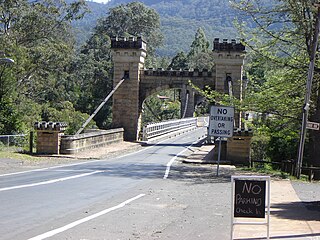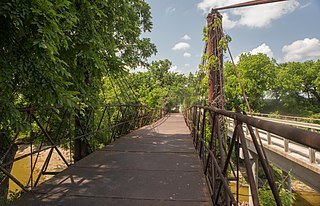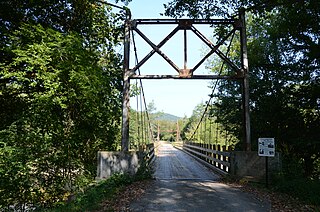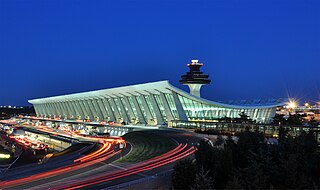
A suspension bridge is a type of bridge in which the deck is hung below suspension cables on vertical suspenders. The first modern examples of this type of bridge were built in the early 1800s. Simple suspension bridges, which lack vertical suspenders, have a long history in many mountainous parts of the world.

A cable-stayed bridge has one or more towers, from which cables support the bridge deck. A distinctive feature are the cables or stays, which run directly from the tower to the deck, normally forming a fan-like pattern or a series of parallel lines. This is in contrast to the modern suspension bridge, where the cables supporting the deck are suspended vertically from the main cable, anchored at both ends of the bridge and running between the towers. The cable-stayed bridge is optimal for spans longer than cantilever bridges and shorter than suspension bridges. This is the range within which cantilever bridges would rapidly grow heavier, and suspension bridge cabling would be more costly.

The John A. Roebling Suspension Bridge is a suspension bridge that spans the Ohio River between Cincinnati, Ohio, and Covington, Kentucky. When opened on December 1, 1866, it was the longest suspension bridge in the world at 1,057 feet (322 m) main span, which was later overtaken by John A. Roebling's most famous design of the 1883 Brooklyn Bridge at 1,595.5 feet (486.3 m). Pedestrians use the bridge to get between the hotels, bars, restaurants, and parking lots in Northern Kentucky. The bar and restaurant district at the foot of the bridge on the Kentucky side is known as Roebling Point.

The eastern span replacement of the San Francisco–Oakland Bay Bridge was a construction project to replace a seismically unsound portion of the Bay Bridge with a new self-anchored suspension bridge (SAS) and a pair of viaducts. The bridge is in the U.S. state of California and crosses the San Francisco Bay between Yerba Buena Island and Oakland. The span replacement took place between 2002 and 2013, and is the most expensive public works project in California history, with a final price tag of $6.5 billion, a 2,500% increase from the original estimate of $250 million, which was an initial estimate for a seismic retrofit of the span, not the full span replacement ultimately completed. Originally scheduled to open in 2007, several problems delayed the opening until September 2, 2013. With a width of 258.33 ft (78.74 m), comprising 10 general-purpose lanes, it is the world's widest bridge according to Guinness World Records.

Hampden Bridge is a heritage-listed single-span suspension bridge that carries Moss Vale Road (B73) across the Kangaroo River, in Kangaroo Valley, in the City of Shoalhaven local government area of New South Wales, Australia. The bridge was designed by Ernest de Burgh and built by Loveridge and Hudson. The property is owned by Transport for NSW. It was added to the New South Wales State Heritage Register on 2 August 2019.

The Waldo–Hancock Bridge was the first long-span suspension bridge erected in Maine, as well as the first permanent bridge across the Penobscot River downstream from Bangor. The name comes from connecting Waldo and Hancock counties. The bridge was built in 1931 and retired in 2006, when the new Penobscot Narrows Bridge was opened just a few yards away. Demolition of the structure was completed by 2013.

The Androscoggin Swinging Bridge is a pedestrian suspension bridge spanning the Androscoggin River in Maine between the towns of Topsham in Sagadahoc County and Brunswick in Cumberland County. The bridge was built in 1892 as a timesaving approach for employees of the Cabot Manufacturing Company of Brunswick, could have safer and easier passage across the river.

The Miami Bridge, also known as the McDaniel Memorial Bridge, is a new concrete girder bridge that was built to replace a cantilever through truss bridge over the Missouri River at Miami, Missouri between Saline County, Missouri and Carroll County, Missouri. The Miami Bridge carries Route 41. The Miami Bridge was built in 1939, and its deck was replaced in 1983 as part of a rehabilitation project. The old bridge's main cantilever span was 474.7 feet, while the two anchor spans were each 415 feet in length, resulting in a total cantilever truss length of 1304.7 feet. There were 11 approach spans, including four Warren deck truss spans, three on the northern approach and one on the southern approach. All remaining approach spans were steel stringer (multi-beam/girder) spans. Total bridge length including approach spans is 2,071.9 feet. The bridge's deck width is 23.0 feet and it has vertical clearance of 16.5 feet.

Chevelon Creek Bridge is a historic road bridge located about 12 miles (19 km) southeast of Winslow, in Navajo County, eastern Arizona, United States. It is a steel Warren Pony truss bridge over Chevelon Creek, built on the first permanent road connecting Holbrook, the seat of Navajo County, and Winslow. When built, the road was regionally important in northern Arizona as well as being a segment of an early national highway at the time automobile traffic was growing and national roads were first being formed. The bridge was listed on the National Register of Historic Places in 1983 for being a rare design in Arizona, part of an early transnational roadway, one of the first bridges built by Arizona after statehood in 1912, and being in nearly original condition.

The Bluff Dale Bridge is a historic cable-stayed bridge located near Bluff Dale, Texas, United States. Built in 1891, the bridge spans 225 feet (69 m) across the Paluxy River. The road deck is 28 feet (8.5 m) above the river and held in place by fourteen 1-inch-diameter (2.5 cm) cables attached to the towers made of 9-inch-diameter (23 cm) iron pipe.

The 1950 Tacoma Narrows Bridge is a suspension bridge in the U.S. state of Washington that carries the westbound lanes of Washington State Route 16 across the Tacoma Narrows strait, between the city of Tacoma and the Kitsap Peninsula. Opened on October 14, 1950, it was built in the same location as the original Tacoma Narrows Bridge, which collapsed due to a windstorm on November 7, 1940. It is the older of the twin bridges that make up the Tacoma Narrows Bridge crossing of the Tacoma Narrows, and carried both directions of traffic across the strait until 2007. At the time of its construction, the bridge was, like its predecessor, the third-longest suspension bridge in the world in terms of main span length, behind the Golden Gate Bridge and George Washington Bridge; it is now the 46th-longest suspension bridge in the world.
Spider Bridge at Falls of Schuylkill was an iron-wire footbridge erected in 1816 over the Schuylkill River, north of Philadelphia, Pennsylvania. Though a modest and temporary structure, it is thought to have been the first wire-cable suspension bridge in the world.

Duck Run Cable Suspension Bridge, also known as Trubada Swinging Bridge, is a historic cable suspension bridge that spans the Little Kanawha River at Trubada, Gilmer County, West Virginia. The bridge was built in 1922. The bridge is 351 feet, 7 inches, with a main span of 209 feet, 9 inches, and two half spans of 76 feet, 6 inches, and 65 feet, 4 inches. It features four reinforced concrete towers for the two wire rope cables.

The Cameron Suspension Bridge crosses the Little Colorado River at Cameron, Arizona, United States.

The Haggard Ford Swinging Bridge is a historic suspension bridge in Boone County, Arkansas. It is located adjacent to Cottonwood Road, about 8 miles (13 km) north of Harrison, and spans Bear Creek. It has cast-in-place concrete abutments, towers, and anchorages, and is supported by steel cables. A wooden deck, one travel lane in width, is suspended from steel hangers. The bridge is about 160 feet (49 m) long. The bridge was built 1938–41 with funding from the Works Progress Administration. Fill surrounding the abutments was washed away in 1945 and subsequently replaced. The bridge deck was replaced in 1977.

The New Portland Wire Bridge is a historic suspension bridge in New Portland, Maine. The bridge carries Wire Bridge Road across the Carrabassett River a short way north of the village center. Built in the mid-19th century, it is one of four 19th-century suspension bridges in the state. It is one lane wide, and has a weight limit of 3 tons. The bridge was listed on the National Register of Historic Places in 1970 and was designated as a Maine Historic Civil Engineering Landmark by the American Society of Civil Engineers in 1990.

The Verde River Sheep Bridge, also known as the Red Point Sheep Bridge, is a suspension bridge which crosses the Verde River in Arizona. Constructed primarily to allow sheep to be driven between grazing ranges on either side of the river. Building started in 1943 and was completed in 1944. Sheep drives stopped in 1978. The bridge was closed in 1987 and largely demolished in 1988. A replica bridge was constructed by the U.S. Forest Service in 1989 to allow hikers access to the Mazatzal Wilderness in Tonto National Forest. The original west suspension tower still remains alongside the replica bridge.

The Sylamore Creek Bridge is a historic bridge in east central Stone County, Arkansas, just south of the Ozark-St. Francis National Forest. It carries County Road 283 across Sylamore Creek, a short way west of Arkansas Highway 9 and north of the Holiday Mountain Resort in Allison. It is a wire-cable suspension bridge, with steel towers mounted on concrete piers supporting four main cables that are anchored into concrete abutments. The bridge is 202 feet (62 m) long, with a deck width of 19 feet 6 inches (5.94 m) and a clearance height of 11 feet (3.4 m). Built in 1945, it is one of three known wire-cable bridges in the state.

Baring Bridge is a one-lane wood and steel cable suspension bridge crossing the South Fork Skykomish River in Baring, Washington, United States. It carries Index Creek Road, which connects a rural area to U.S. Route 2 in unincorporated King County. Built in 1930, it is one of only two wooden suspension bridges designed for vehicle use in Washington that remain active and was added to the National Register of Historic Places in August 2019.

A suspended structure is a structure which is supported by cables coming from beams or trusses which sit atop a concrete center column or core. The design allows the walls, roof and cantilevered floors to be supported entirely by cables and a center column.






















